EFN 422: Microeconomic Analysis of Taxi Industry Regulation and Uber
VerifiedAdded on 2023/01/03
|6
|1423
|92
Essay
AI Summary
This essay provides a microeconomic analysis of the Australian taxi industry, focusing on the effects of government regulations and the disruptive entry of Uber. It examines how limitations on taxi licenses have raised costs for consumers and hindered innovation, leading to a regulated monopoly. The essay explores the impact of price ceilings, which restrict taxi drivers from charging market-determined fares, resulting in reduced consumer surplus and excess demand. Furthermore, it discusses the market structure and policy implications of ride-sharing apps like Uber, which have significantly impacted the traditional taxi industry. The analysis highlights the need for deregulation, incentive programs, and a more flexible pricing model to protect the taxi industry while ensuring consumer welfare. The essay concludes that government regulations have adversely affected both consumers and the taxi industry, emphasizing the importance of market efficiency and consumer surplus.
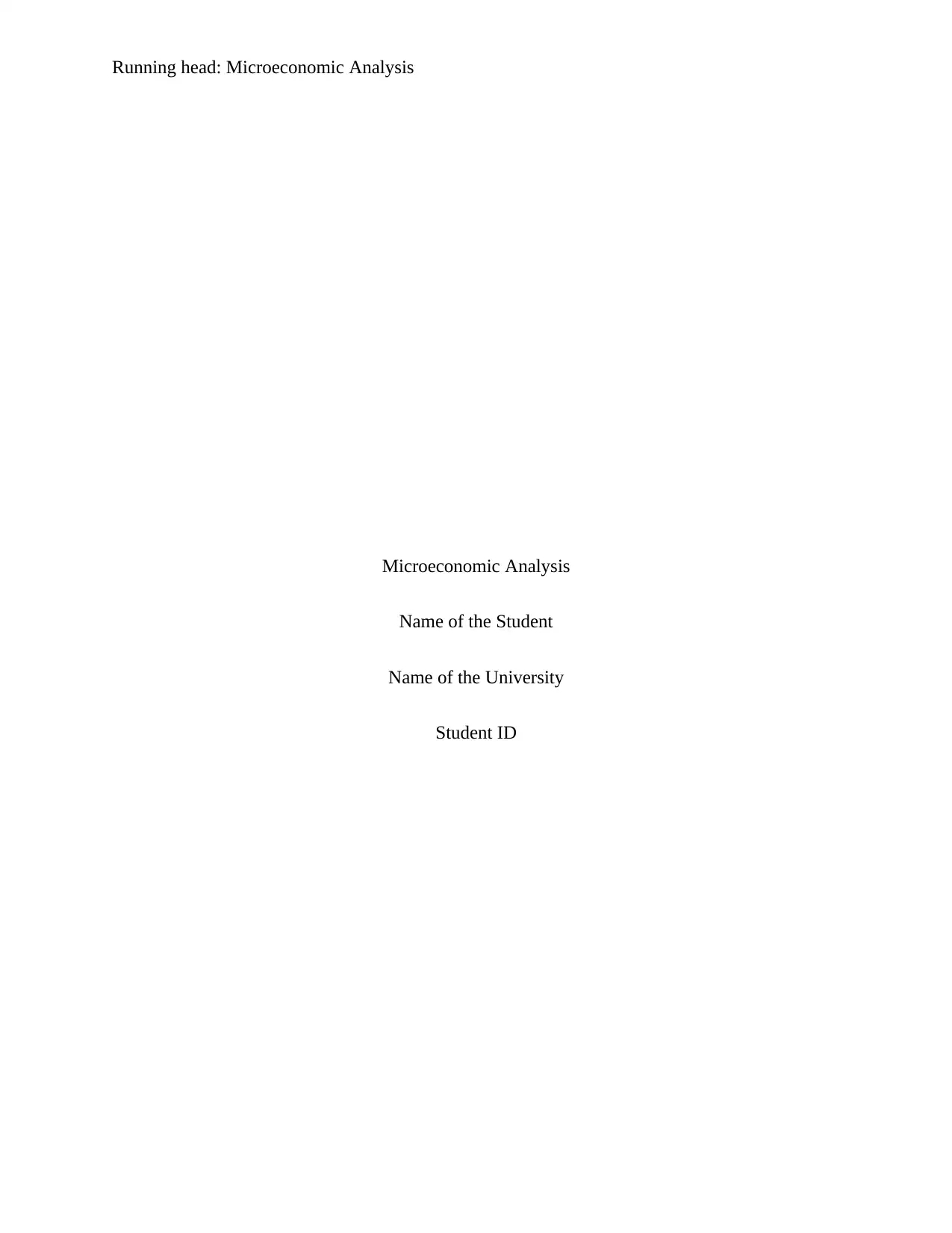
Running head: Microeconomic Analysis
Microeconomic Analysis
Name of the Student
Name of the University
Student ID
Microeconomic Analysis
Name of the Student
Name of the University
Student ID
Paraphrase This Document
Need a fresh take? Get an instant paraphrase of this document with our AI Paraphraser
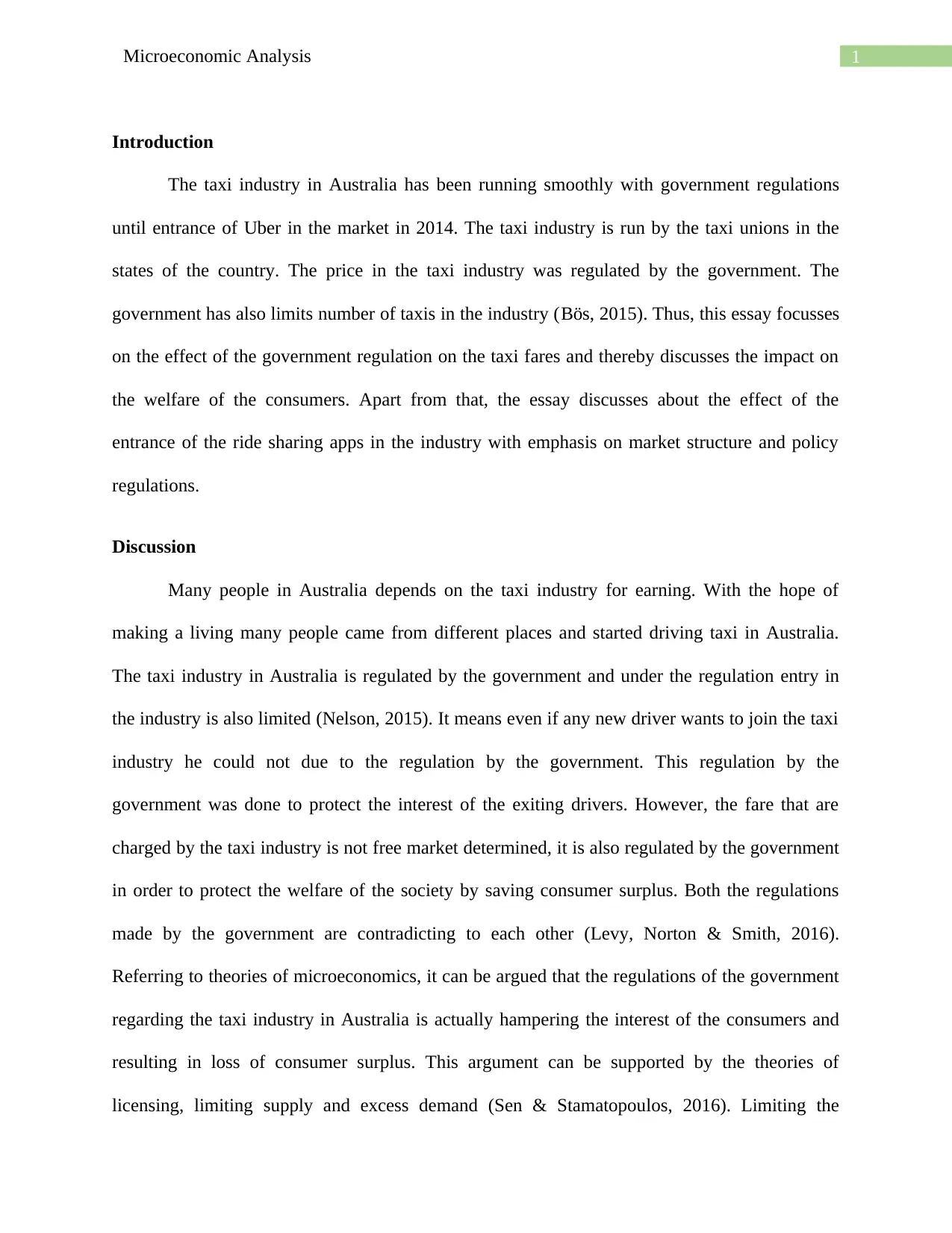
1Microeconomic Analysis
Introduction
The taxi industry in Australia has been running smoothly with government regulations
until entrance of Uber in the market in 2014. The taxi industry is run by the taxi unions in the
states of the country. The price in the taxi industry was regulated by the government. The
government has also limits number of taxis in the industry (Bös, 2015). Thus, this essay focusses
on the effect of the government regulation on the taxi fares and thereby discusses the impact on
the welfare of the consumers. Apart from that, the essay discusses about the effect of the
entrance of the ride sharing apps in the industry with emphasis on market structure and policy
regulations.
Discussion
Many people in Australia depends on the taxi industry for earning. With the hope of
making a living many people came from different places and started driving taxi in Australia.
The taxi industry in Australia is regulated by the government and under the regulation entry in
the industry is also limited (Nelson, 2015). It means even if any new driver wants to join the taxi
industry he could not due to the regulation by the government. This regulation by the
government was done to protect the interest of the exiting drivers. However, the fare that are
charged by the taxi industry is not free market determined, it is also regulated by the government
in order to protect the welfare of the society by saving consumer surplus. Both the regulations
made by the government are contradicting to each other (Levy, Norton & Smith, 2016).
Referring to theories of microeconomics, it can be argued that the regulations of the government
regarding the taxi industry in Australia is actually hampering the interest of the consumers and
resulting in loss of consumer surplus. This argument can be supported by the theories of
licensing, limiting supply and excess demand (Sen & Stamatopoulos, 2016). Limiting the
Introduction
The taxi industry in Australia has been running smoothly with government regulations
until entrance of Uber in the market in 2014. The taxi industry is run by the taxi unions in the
states of the country. The price in the taxi industry was regulated by the government. The
government has also limits number of taxis in the industry (Bös, 2015). Thus, this essay focusses
on the effect of the government regulation on the taxi fares and thereby discusses the impact on
the welfare of the consumers. Apart from that, the essay discusses about the effect of the
entrance of the ride sharing apps in the industry with emphasis on market structure and policy
regulations.
Discussion
Many people in Australia depends on the taxi industry for earning. With the hope of
making a living many people came from different places and started driving taxi in Australia.
The taxi industry in Australia is regulated by the government and under the regulation entry in
the industry is also limited (Nelson, 2015). It means even if any new driver wants to join the taxi
industry he could not due to the regulation by the government. This regulation by the
government was done to protect the interest of the exiting drivers. However, the fare that are
charged by the taxi industry is not free market determined, it is also regulated by the government
in order to protect the welfare of the society by saving consumer surplus. Both the regulations
made by the government are contradicting to each other (Levy, Norton & Smith, 2016).
Referring to theories of microeconomics, it can be argued that the regulations of the government
regarding the taxi industry in Australia is actually hampering the interest of the consumers and
resulting in loss of consumer surplus. This argument can be supported by the theories of
licensing, limiting supply and excess demand (Sen & Stamatopoulos, 2016). Limiting the
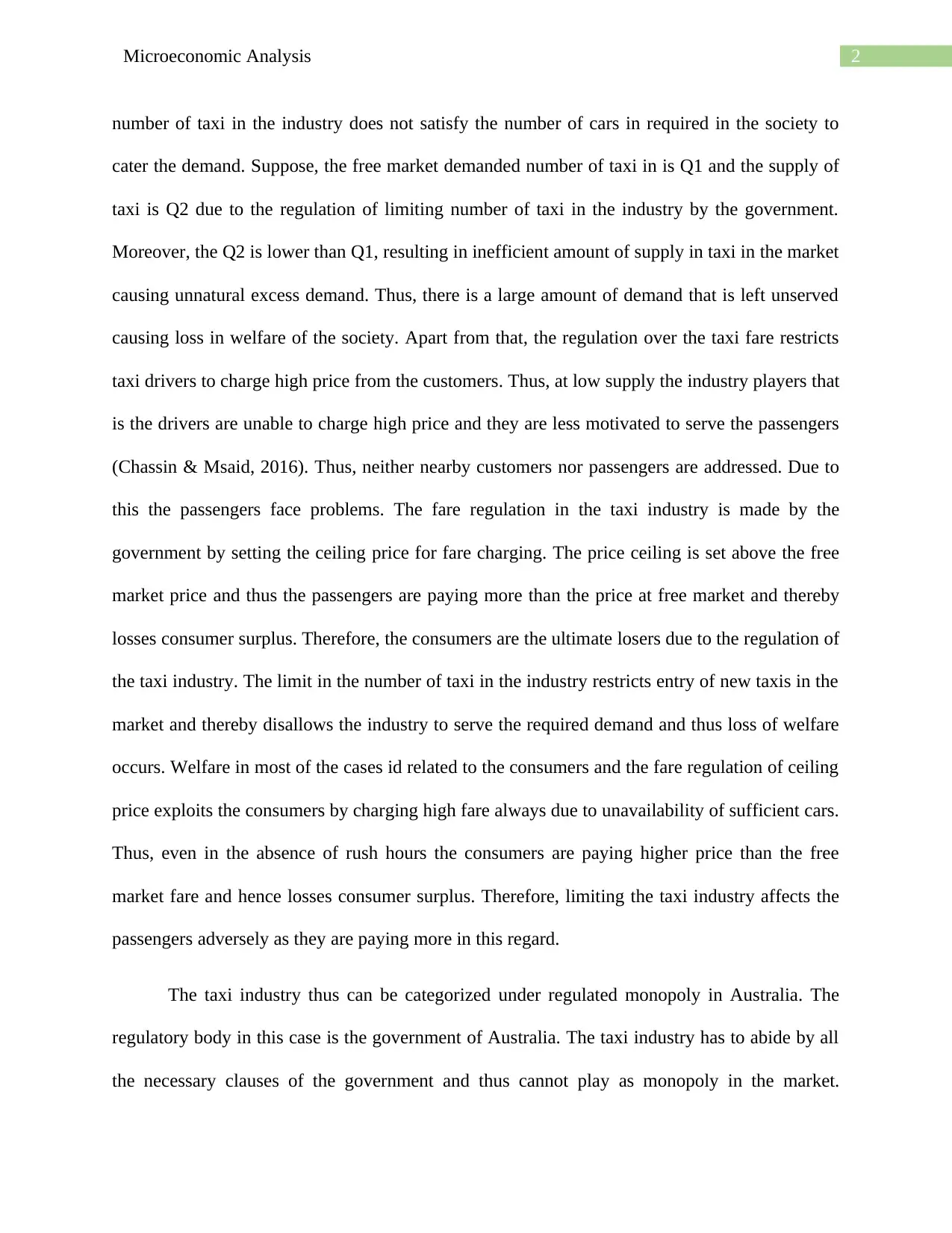
2Microeconomic Analysis
number of taxi in the industry does not satisfy the number of cars in required in the society to
cater the demand. Suppose, the free market demanded number of taxi in is Q1 and the supply of
taxi is Q2 due to the regulation of limiting number of taxi in the industry by the government.
Moreover, the Q2 is lower than Q1, resulting in inefficient amount of supply in taxi in the market
causing unnatural excess demand. Thus, there is a large amount of demand that is left unserved
causing loss in welfare of the society. Apart from that, the regulation over the taxi fare restricts
taxi drivers to charge high price from the customers. Thus, at low supply the industry players that
is the drivers are unable to charge high price and they are less motivated to serve the passengers
(Chassin & Msaid, 2016). Thus, neither nearby customers nor passengers are addressed. Due to
this the passengers face problems. The fare regulation in the taxi industry is made by the
government by setting the ceiling price for fare charging. The price ceiling is set above the free
market price and thus the passengers are paying more than the price at free market and thereby
losses consumer surplus. Therefore, the consumers are the ultimate losers due to the regulation of
the taxi industry. The limit in the number of taxi in the industry restricts entry of new taxis in the
market and thereby disallows the industry to serve the required demand and thus loss of welfare
occurs. Welfare in most of the cases id related to the consumers and the fare regulation of ceiling
price exploits the consumers by charging high fare always due to unavailability of sufficient cars.
Thus, even in the absence of rush hours the consumers are paying higher price than the free
market fare and hence losses consumer surplus. Therefore, limiting the taxi industry affects the
passengers adversely as they are paying more in this regard.
The taxi industry thus can be categorized under regulated monopoly in Australia. The
regulatory body in this case is the government of Australia. The taxi industry has to abide by all
the necessary clauses of the government and thus cannot play as monopoly in the market.
number of taxi in the industry does not satisfy the number of cars in required in the society to
cater the demand. Suppose, the free market demanded number of taxi in is Q1 and the supply of
taxi is Q2 due to the regulation of limiting number of taxi in the industry by the government.
Moreover, the Q2 is lower than Q1, resulting in inefficient amount of supply in taxi in the market
causing unnatural excess demand. Thus, there is a large amount of demand that is left unserved
causing loss in welfare of the society. Apart from that, the regulation over the taxi fare restricts
taxi drivers to charge high price from the customers. Thus, at low supply the industry players that
is the drivers are unable to charge high price and they are less motivated to serve the passengers
(Chassin & Msaid, 2016). Thus, neither nearby customers nor passengers are addressed. Due to
this the passengers face problems. The fare regulation in the taxi industry is made by the
government by setting the ceiling price for fare charging. The price ceiling is set above the free
market price and thus the passengers are paying more than the price at free market and thereby
losses consumer surplus. Therefore, the consumers are the ultimate losers due to the regulation of
the taxi industry. The limit in the number of taxi in the industry restricts entry of new taxis in the
market and thereby disallows the industry to serve the required demand and thus loss of welfare
occurs. Welfare in most of the cases id related to the consumers and the fare regulation of ceiling
price exploits the consumers by charging high fare always due to unavailability of sufficient cars.
Thus, even in the absence of rush hours the consumers are paying higher price than the free
market fare and hence losses consumer surplus. Therefore, limiting the taxi industry affects the
passengers adversely as they are paying more in this regard.
The taxi industry thus can be categorized under regulated monopoly in Australia. The
regulatory body in this case is the government of Australia. The taxi industry has to abide by all
the necessary clauses of the government and thus cannot play as monopoly in the market.
⊘ This is a preview!⊘
Do you want full access?
Subscribe today to unlock all pages.

Trusted by 1+ million students worldwide
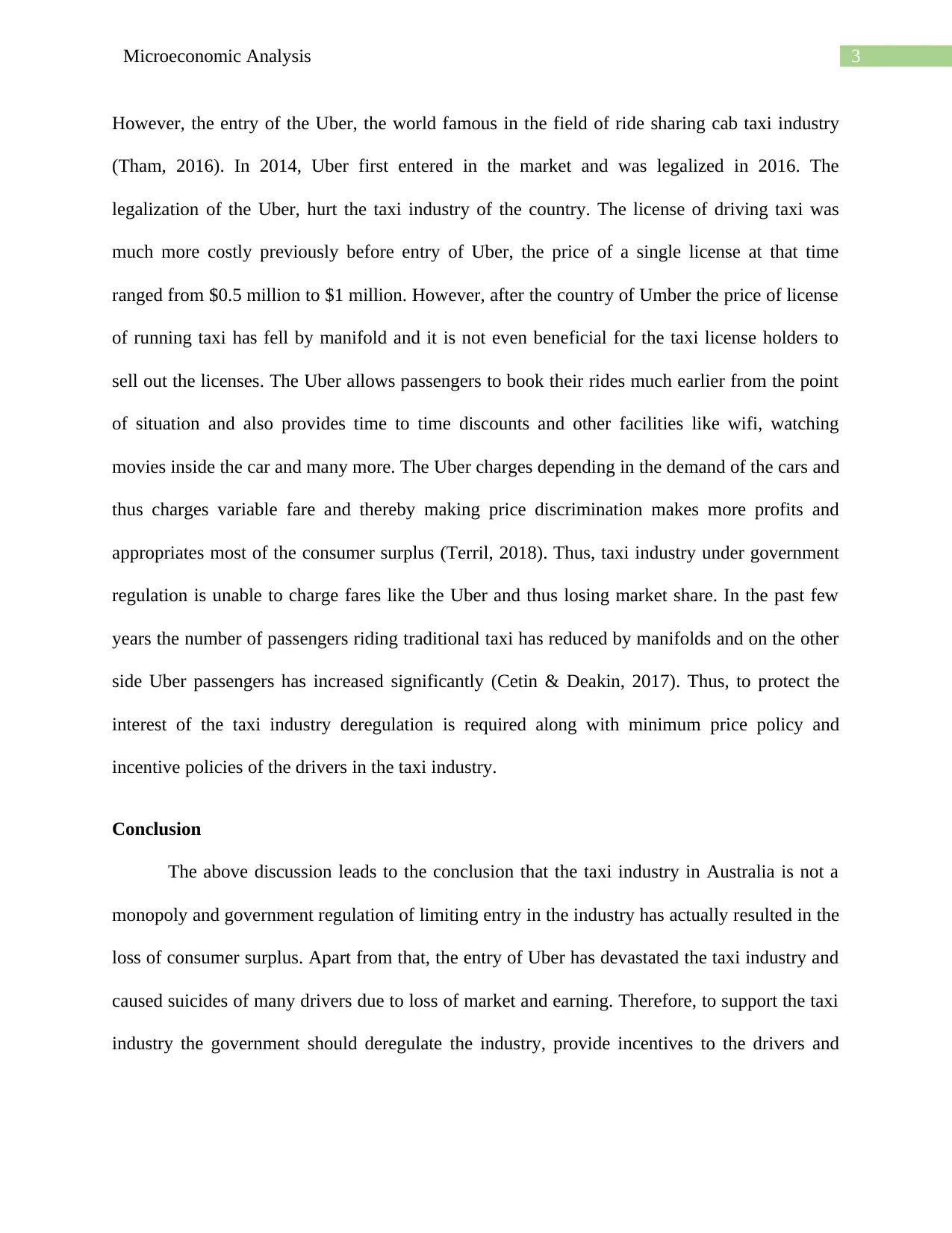
3Microeconomic Analysis
However, the entry of the Uber, the world famous in the field of ride sharing cab taxi industry
(Tham, 2016). In 2014, Uber first entered in the market and was legalized in 2016. The
legalization of the Uber, hurt the taxi industry of the country. The license of driving taxi was
much more costly previously before entry of Uber, the price of a single license at that time
ranged from $0.5 million to $1 million. However, after the country of Umber the price of license
of running taxi has fell by manifold and it is not even beneficial for the taxi license holders to
sell out the licenses. The Uber allows passengers to book their rides much earlier from the point
of situation and also provides time to time discounts and other facilities like wifi, watching
movies inside the car and many more. The Uber charges depending in the demand of the cars and
thus charges variable fare and thereby making price discrimination makes more profits and
appropriates most of the consumer surplus (Terril, 2018). Thus, taxi industry under government
regulation is unable to charge fares like the Uber and thus losing market share. In the past few
years the number of passengers riding traditional taxi has reduced by manifolds and on the other
side Uber passengers has increased significantly (Cetin & Deakin, 2017). Thus, to protect the
interest of the taxi industry deregulation is required along with minimum price policy and
incentive policies of the drivers in the taxi industry.
Conclusion
The above discussion leads to the conclusion that the taxi industry in Australia is not a
monopoly and government regulation of limiting entry in the industry has actually resulted in the
loss of consumer surplus. Apart from that, the entry of Uber has devastated the taxi industry and
caused suicides of many drivers due to loss of market and earning. Therefore, to support the taxi
industry the government should deregulate the industry, provide incentives to the drivers and
However, the entry of the Uber, the world famous in the field of ride sharing cab taxi industry
(Tham, 2016). In 2014, Uber first entered in the market and was legalized in 2016. The
legalization of the Uber, hurt the taxi industry of the country. The license of driving taxi was
much more costly previously before entry of Uber, the price of a single license at that time
ranged from $0.5 million to $1 million. However, after the country of Umber the price of license
of running taxi has fell by manifold and it is not even beneficial for the taxi license holders to
sell out the licenses. The Uber allows passengers to book their rides much earlier from the point
of situation and also provides time to time discounts and other facilities like wifi, watching
movies inside the car and many more. The Uber charges depending in the demand of the cars and
thus charges variable fare and thereby making price discrimination makes more profits and
appropriates most of the consumer surplus (Terril, 2018). Thus, taxi industry under government
regulation is unable to charge fares like the Uber and thus losing market share. In the past few
years the number of passengers riding traditional taxi has reduced by manifolds and on the other
side Uber passengers has increased significantly (Cetin & Deakin, 2017). Thus, to protect the
interest of the taxi industry deregulation is required along with minimum price policy and
incentive policies of the drivers in the taxi industry.
Conclusion
The above discussion leads to the conclusion that the taxi industry in Australia is not a
monopoly and government regulation of limiting entry in the industry has actually resulted in the
loss of consumer surplus. Apart from that, the entry of Uber has devastated the taxi industry and
caused suicides of many drivers due to loss of market and earning. Therefore, to support the taxi
industry the government should deregulate the industry, provide incentives to the drivers and
Paraphrase This Document
Need a fresh take? Get an instant paraphrase of this document with our AI Paraphraser
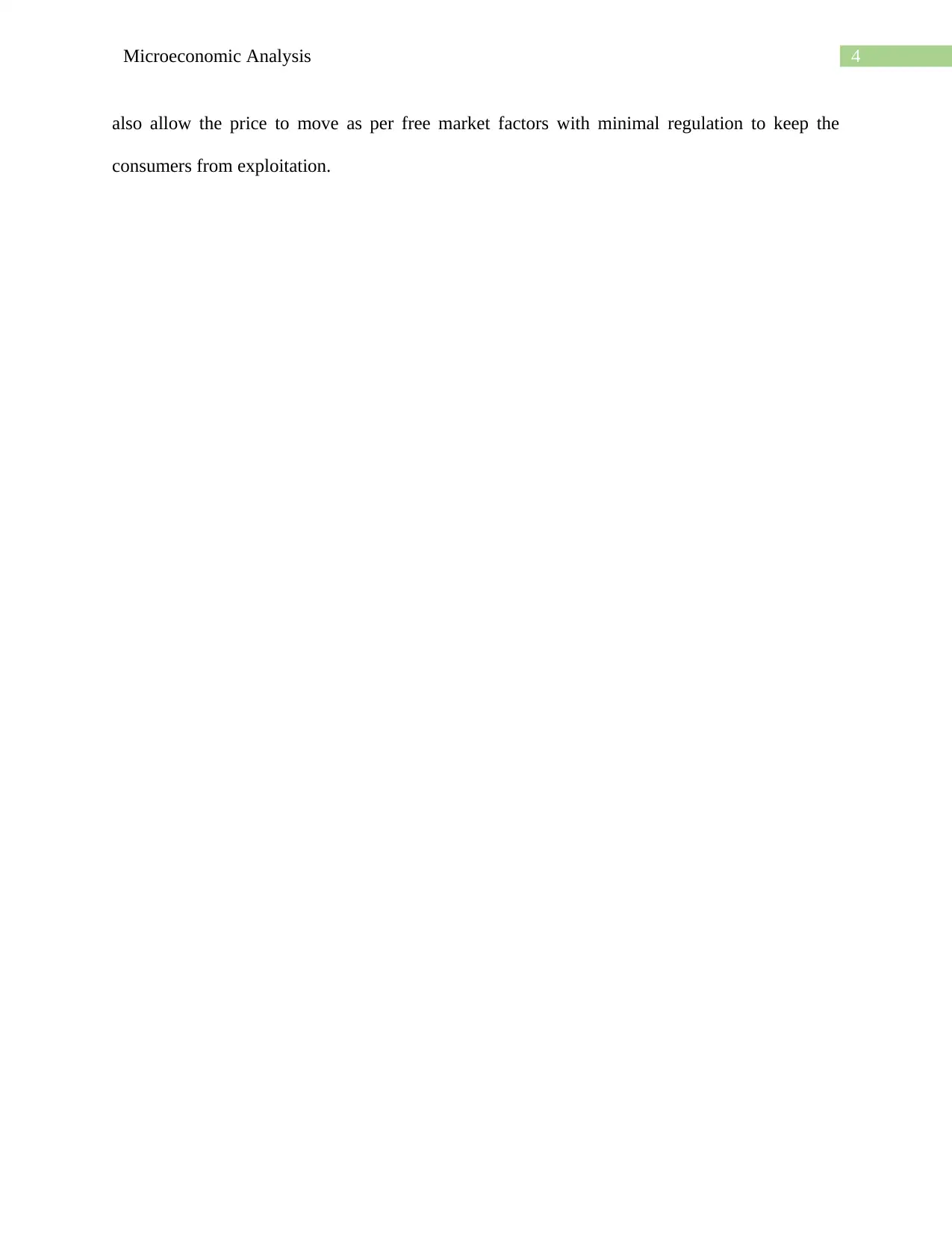
4Microeconomic Analysis
also allow the price to move as per free market factors with minimal regulation to keep the
consumers from exploitation.
also allow the price to move as per free market factors with minimal regulation to keep the
consumers from exploitation.
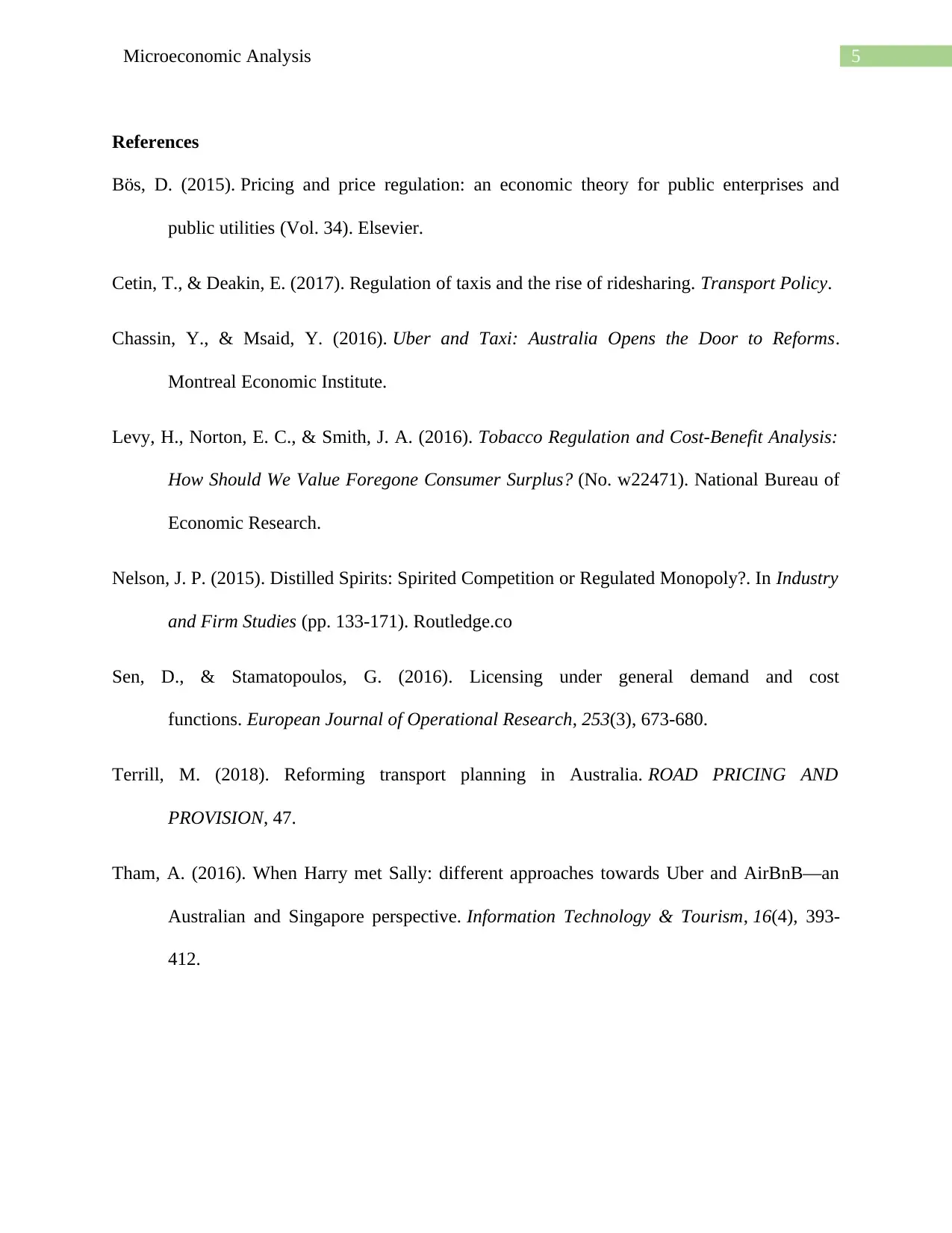
5Microeconomic Analysis
References
Bös, D. (2015). Pricing and price regulation: an economic theory for public enterprises and
public utilities (Vol. 34). Elsevier.
Cetin, T., & Deakin, E. (2017). Regulation of taxis and the rise of ridesharing. Transport Policy.
Chassin, Y., & Msaid, Y. (2016). Uber and Taxi: Australia Opens the Door to Reforms.
Montreal Economic Institute.
Levy, H., Norton, E. C., & Smith, J. A. (2016). Tobacco Regulation and Cost-Benefit Analysis:
How Should We Value Foregone Consumer Surplus? (No. w22471). National Bureau of
Economic Research.
Nelson, J. P. (2015). Distilled Spirits: Spirited Competition or Regulated Monopoly?. In Industry
and Firm Studies (pp. 133-171). Routledge.co
Sen, D., & Stamatopoulos, G. (2016). Licensing under general demand and cost
functions. European Journal of Operational Research, 253(3), 673-680.
Terrill, M. (2018). Reforming transport planning in Australia. ROAD PRICING AND
PROVISION, 47.
Tham, A. (2016). When Harry met Sally: different approaches towards Uber and AirBnB—an
Australian and Singapore perspective. Information Technology & Tourism, 16(4), 393-
412.
References
Bös, D. (2015). Pricing and price regulation: an economic theory for public enterprises and
public utilities (Vol. 34). Elsevier.
Cetin, T., & Deakin, E. (2017). Regulation of taxis and the rise of ridesharing. Transport Policy.
Chassin, Y., & Msaid, Y. (2016). Uber and Taxi: Australia Opens the Door to Reforms.
Montreal Economic Institute.
Levy, H., Norton, E. C., & Smith, J. A. (2016). Tobacco Regulation and Cost-Benefit Analysis:
How Should We Value Foregone Consumer Surplus? (No. w22471). National Bureau of
Economic Research.
Nelson, J. P. (2015). Distilled Spirits: Spirited Competition or Regulated Monopoly?. In Industry
and Firm Studies (pp. 133-171). Routledge.co
Sen, D., & Stamatopoulos, G. (2016). Licensing under general demand and cost
functions. European Journal of Operational Research, 253(3), 673-680.
Terrill, M. (2018). Reforming transport planning in Australia. ROAD PRICING AND
PROVISION, 47.
Tham, A. (2016). When Harry met Sally: different approaches towards Uber and AirBnB—an
Australian and Singapore perspective. Information Technology & Tourism, 16(4), 393-
412.
⊘ This is a preview!⊘
Do you want full access?
Subscribe today to unlock all pages.

Trusted by 1+ million students worldwide
1 out of 6
Related Documents
Your All-in-One AI-Powered Toolkit for Academic Success.
+13062052269
info@desklib.com
Available 24*7 on WhatsApp / Email
![[object Object]](/_next/static/media/star-bottom.7253800d.svg)
Unlock your academic potential
Copyright © 2020–2025 A2Z Services. All Rights Reserved. Developed and managed by ZUCOL.





